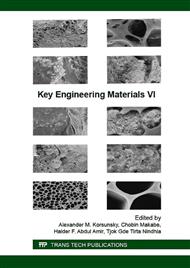p.283
p.291
p.297
p.304
p.309
p.315
p.323
p.332
p.338
In Vitro Bioactivity of Macroporous Calcium Phosphate Scaffold for Biomedical Application
Abstract:
In this study, the effects of macroporous calcium phosphate (MCP) scaffold on bioactivity as an in-vitro model has been investigated. MCP scaffold was prepared using foam replication technique by combination of ceramic and polyurethane (PU). MCP was examined by scanning electron microscope (SEM) and X-ray diffractometer (XRD) to confirm its microstructure and phase composition respectively. Bioactivity in simulated body fluid (SBF) was characterized by apatite mineralisation on MCP scaffold surface, pH, calcium (Ca2+) and phosphate (PO43-) ion dissolution and compressive strength using universal testing machine (UTM). Experimental results showed the formation of apatite around the MCP scaffold after 30 days in SBF. pH value was gradually decreased up to 7 days and constant until 30 days. Dissolution of Ca2+ and PO43- ion in SBF due to the occurrence of MCP degradation, hence the compressive strength are gradually decreased gradually in line with immersion period. This material may be promising for biomedical application.
Info:
Periodical:
Pages:
309-314
Citation:
Online since:
August 2016
Keywords:
Price:
Сopyright:
© 2016 Trans Tech Publications Ltd. All Rights Reserved
Share:
Citation:


